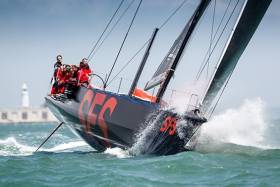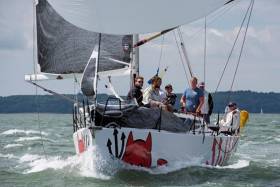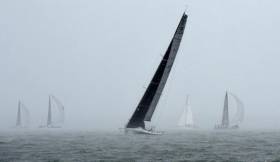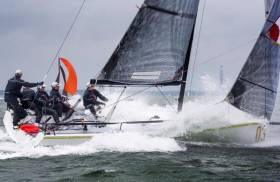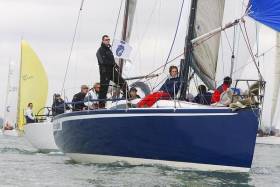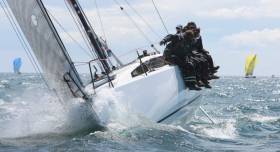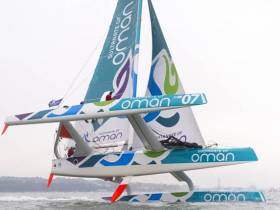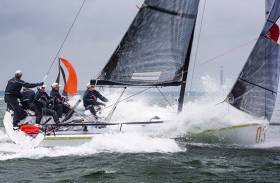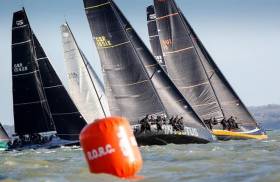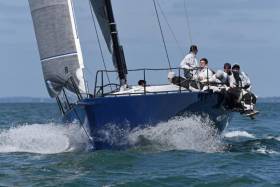Displaying items by tag: Royal Ocean Racing Club
RORC Cowes–Dinard–St.Malo Race Goes To French Volvo 70
French teams dominated the 2016 RORC Cowes Dinard St Malo Race, with seven classes and the overall win going to French teams. Ironically it was the multihull class, for many years dominated by the French, that Great Britain had its only victory.Tony Lawson's British MOD70 Concise 10, skippered by Ned Collier Wakefield took multihull line honours in an elapsed time of 10 hours 32 minutes 50 seconds and was the winner after time correction.
Lionel Péan's Volvo 70, Sfs II took monohull line honours, in an elapsed time of 14 hours 33 minutes 03 seconds and after time correction was declared the overall winner. Although he grew up in La Rochelle, St Malo was home when Péan skippered L'Esprit d’Equipe to victory in the 1985 Whitbread Round the World Race.
“It is normal for us to take line honours, as we are the fastest boat but to win overall is very special for me and the crew” commented Lionel Péan. “It was a beat all the way to Guernsey with the wind getting up to about 20 knots and then the wind just died at the moment we needed to tack around the islands, so that was frustrating. However, the wind came back up to about 10 knots which was enough for us to finish at a good speed. It was great to be back in St Malo, with all the classic boats I remember from years ago. 30 years ago, almost to the day, we sailed into St Malo as winners of the Whitbread. For this race, Eric Sendra was on board, as he was for the Whitbread 30 years ago and Sébastien Audigan, who is incredible. However, most of the team are young and we are looking to build up a team for the 2020 Volvo Ocean Race.”
In IRC One, Jacques Pelletier's Milon 41 L'Ange De Milon was the winner, ahead of former RORC Commodore, Mike Greville, racing Ker 39, Erivale III. Alan Hannon's RP45 Katsu was third in class, putting his team up to second overall for the RORC Season's Points Championship. Nick Jones’s First 44.7 Lisa was fifth in class and still leads the series overall. The RORC Team of Katsu and Lisa also walked away with the John West Trophy for the best 2 boats from a club in IRC Overall.
In IRC Two, Gilles Fournier's J/133 Pintia, enjoyed their fourth class win of the season. Ross Applebey's Scarlet Oyster, returning to RORC action for the first time since the RORC Caribbean 600, finished just under two minutes behind Pintia after time correction to hold on to second. Herve Benic's French First 40 Iritis was third.
In IRC Three, Marc Alperovitch's JPK 10.80 Timeline, which will be representing France in the Brewin Dolphin Commodores' Cup, was the victor. Arnaud Delamare and Eric Mordret's JPK 10.80 Dream Pearls was second but still retains the class lead for the championship.
Jean-Eudes Renier's JPK 10.80 Shaitan was third in IRC Three and the winner of IRC Two Handed Class after a terrific battle with Chris Frost and Elin Haf Davies J/120 Nunatak. The British pair crossed the finish line just in front of Shaitan but after time correction, the class win went to Jean-Eudes Renier's team. Chris Schram's J/120 Maverick was third having led both Shaitan and Nunatak for most of the race but sailed into a wind hole near |Les |Minquiers and watched the others sail around them.
In IRC Four, Noel Racine JPK 10.10 Foggy Dew was the runaway winner, taking line honours for the class and the corrected time win by several hours. Racine was very pleased with the win which he put down to their negotiation of the tricky tidal conditions at Les Casquets, wriggling through just before the wind dropped. Cooper & England's Dehler 38 Longue Pierre was second with Jonathan Rolls' Swan 38 Xara. Foggy Dew now leads IRC Four for the season.
Halvard Mabire's Class 40 Campagne De France completed the rout for France winning the Class 40 division. Adriaan van Oord Dutch team racing Moonpalace was second with Christophe Coatnoan's Partouche is third.
The RORC Season's Points Championship continues with the Channel Race starting on the 30th July from Cowes around marks with a Solent finish, the race will be between 100-140 miles.
With the deadline for entries into the 2016 Brewin Dolphin Commodores' Cup now passed, eight three boat teams are set to contest the Royal Ocean Racing Club's biennial championship for Corinthian crews, taking place out of Cowes over 23-30th July.
Teams for the 13th Brewin Dolphin Commodores' Cup, comprise three from Team France, two from Team GBR and others from Flanders North Sea and, for the first time, Israel. The last to raise its head above the parapet is the Celtic Team, comprising two boats from Scotland and one from France.
The Celtic Team has been masterminded by Scottish adventurer, Jock Wishart, who is campaigning Jean-Eudes Renier's JPK 10.80, Shaitan. Shaitan is joined by the Corby 37, Aurora, which co-owners Roderick Stuart and Bill Ram's raced in the Scottish team in 2014 and originally, when new was Eamonn Rohan's Blondie III and competed for Ireland in 2006. The Celtic team's small boat is a new JPK 10.10, Space Oddity, campaigned by St Malo-based sailmaker, Marc Noël.
Once upon a time a grinder on Lionheart in the America's Cup, Wishart is best known for his epic expeditions. Way too numerous to list in full, these have included rowing across the Atlantic, the fastest circumnavigation of the globe in a powered vessel (Cable & Wireless Adventurer), rowing to the geomagnetic North Pole, various other expeditions to the North Pole, including, last year, the Arctic Rugby Challenge, a trek there to play the 'most northerly rugby match in history'.
Wishart has previously crewed in the Brewin Dolphin Commodores' Cup, but this is the first campaign of his own. He admits: "It has always been one of those things that I've always wanted to do. Everything came together - I haven't got a big expedition on this year, so it was time to do a bit of sailing."
He took delivery of Shaitan just four weeks ago and, after two training weekends, has taken to the race course and in the recent RORC IRC Nationals, finishing ninth in the 19-boat IRC Two class.
As to this year's Brewin Dolphin Commodores' Cup, Wishart observes: "There are no weak teams - they're all strong. It is going to be very, very competitive and that is good for the event."
 JPK 10.80, Shaitan in the recent RORC IRC Nationals Photo: Rick Tomlinson/RORC JPK 10.80, Shaitan in the recent RORC IRC Nationals Photo: Rick Tomlinson/RORC |
According to Aurora's Rod Stuart, their aim had been to field another Scottish team as in 2014, but they were unable to muster a small boat. He is pleased with the new arrangement: "Scots and French sailing together, it's an old alliance and should be a lot of fun. I don't think it will be as 'stiff upper lip' as being part of GBR!"
In his youth, Stuart raced a 30ft trimaran solo the 'wrong way' across the North Atlantic in the 1988 OSTAR, convincingly winning his class ahead of a young Royal Marine called Pete Goss.
His present campaign began six years ago aboard an Elan 410, EOS. "In the front of the boat were all young Laser sailors in their late teens from the RYA centre at Cumbrae," Stuart recounts. "We started pretty awfully, but four years later we were on the podium in the Scottish Series and in Dun Laoghaire, etc."
They also raced numerous offshores such as Round Ireland, the Rolex Fastnet Race and the 2013 Middle Sea Race, in which they finished second in a 30-strong IRC Two. They acquired Aurora for the 2014 Brewin Dolphin Commodores' Cup and have been 'learning the boat' ever since.
Stuart is a big fan of the Brewin Dolpin Commodores' Cup: "There are lots of special things about it - it is very intense and very tiring and you are sailing against a selection of the best boats from all these different countries."
"For us this is a continuation of our learning process. We finished two years ago feeling that we could do better. On the way back home we decided we were going to come back again."
However as Stuart observes: "Since the boat's called Space Oddity, he [Marc Noël] is clearly a Bowie fan, so he's got to be alright..."
 Roderick Stuart and Bill Ram's Corby 37, Aurora competed as part of the Scottish team in the 2014 Brewin Dolphin Commodores' Cup Photo: Rick Tomlinson/RORC Roderick Stuart and Bill Ram's Corby 37, Aurora competed as part of the Scottish team in the 2014 Brewin Dolphin Commodores' Cup Photo: Rick Tomlinson/RORC |
Eddie Warden Owen, CEO of the RORC welcomed the eighth team: "As a Welshman I am delighted to see a Celtic team, which is the initiative of my good friend Jock Wishart. There is a good mix of teams this year; the standard is high and there's no stand-out team, so predicting a winner is impossible which is very good for the teams and the event. For sure I'll be rooting for the Celts."
Royal Cork Yachts Race at RORC IRC National Championship Sails in Thunder & Lightning
Royal Cork's Antix (Anthony O'Leary) is sailing in the Fast 40 class and Jump Juice (Conor Phelan) is sailing in Class 1of the Royal Ocean Racing Club's IRC National Championship on the Solent. After race six, Jump is lying sixth and Antix is lying eighth. Results on RORC's facebook page are here.
With micro-storms, intense, frequent deluges, thunder and lightning, conditions for day two of the IRC Nationals resembled an episode from the Old Testament; the Great Flood perhaps.
This made for a "very testing day," recounted Race Officer, Stuart Childerley. "It looked really good for half an hour, but then very quickly, shower cells developed, creating havoc."
The 61 strong fleet was initially packed off on a windward-leeward course. However, as Childerley explained: "For those, you expect half decent conditions to make it fair, while we were seeing a number of shifts and the wind was up and down. Then the wind just dropped out completely. So the decision-making process wasn't in their hands and I abandoned that one."
Unfortunately from then on, conditions turned 'biblical' as a stream of storms cells rolled across the Solent, causing the wind range to span nothing to 20 knots, with giant shifts.
During a momentary break, one round the cans race, where the wind direction was less critical, was successfully completed, albeit with a few stop-starts. While the intention was to hold three races, in fact after some patient waiting by increasingly soggy crew, the decision was made to send the fleet in, after the conditions failed to stabilise.
Today's race was special as its winners, across each of the five classes, were awarded a 'Tiny Mitchell trophy' named after the founder of the club that is now RORC Cowes.
In the FAST40+ class, Peter Morton's Carkeek 40 Mk3, Girls On Film, scored her third bullet today and now holds a four point lead over Sir Keith Mills' Invictus. Coming second today, and now third overall, is South African Mike Bartholomew's GP42, Tokoloshe II.
"We had a lucky break," admitted Bartholomew. "The wind was all over the place and positions were changing frequently." Tokoloshe was OCS and then found the wrong end of a shift on the first beat. "But then we were in the right place at the right time on the last leg and got a private little breeze in the middle and pulled away as it shut down behind us, Bartholomew continued. "It was as simple as that."
In IRC One, Rod Stuart, skipper of the Scottish Corby 37, Aurora, was delighted to have won today's race, as he thought they had been fourth. This leaves Aurora second overall, tied with Seb Blair's King 40, Cobra.
As to how he found today, Stuart said: "It is just like sailing in Scotland - wet, wet, wet! There were a lot of different conditions all of the time and the thunder and lightning added a different dimension to it, as did the frequently diminished visibility!"
In IRC Two, the largest class at the IRC Nationals, today's surprise winner was Andy Theobald's J/122, R&W, which in yesterday's four races had been unable to finish a race better than 13th. However today they were on fire, winning the race and the Tiny Mitchell trophy.
Adam Gosling's JPK 10.80+ Yes!, finished third to retain the lead overall in IRC Two, three points ahead of the Dutch team on Frans Rodenburg's Elke, the highest rated of five First 40s competing.
Rodenburg said he is enjoying the high level of racing at the IRC Nationals, especially among the First 40s and in particular against La Réponse, of RORC Admiral Andrew McIrvine.
"In the Netherlands there are less racing boats, so we come here to find competition. We are pleased to be doing so well," said Rodenburg.
In the abandoned race, the Dutch team had been out in front and were confident they were winning before the plug was pulled on it. Finishing second in the race that was then completed, came as compensation. "I think overall we made good calls," explained Rodenburg. "We had to decide which sail to use - we were thinking 'Code 0', but we used a jib, which was good and we gained some distance upwind. On the last leg we tried to overtake R&W, but they kept covering us and we couldn't pass them."
Another Dutch team won today in IRC Three: In the five races held to date, Willem Schopman's Bashford Howison 36, Intention, has yet to finish off the podium. Yet they remain third overall, behind Benoit D'halluin's A35, Dunkerque-Les Dunes de Flandre, and the British J/35, Bengal Magic, with two bullets apiece.
Finally in the five boat HP30 class, today's winner was Malcolm Wootton's Farr 30, Pegasus, leaving her second overall to John Reivers' Melges 32, Drop Bear M32.
To make up for today's lost races, the aim is to start half an hour earlier for tomorrow, the final day of competition, with a warning signal at 0955. The intention is to run two windward-leewards and one round the cans race. The forecast is for 8-12 knots from the southwest.
Following on from last week's Irish IRC Nationals at Howth, the cream of the British IRC fleet, from both the UK and abroad, will include several brand new race boats going head to head over 24-26th June at the Royal Ocean Racing Club's IRC National Championship.
The three day long regatta will include a mix of windward-leeward and round the cans courses on the Solent to determine the 2016 IRC National Champion.
At the regatta, attention will be particularly on the two new IRC-based box rule classes making their debut this year: the Fast 40+ and the HP30.
Leading the charge will be the ten Fast 40+ yachts. This new breed is already providing some of the most competitive home-grown grand prix-level handicap keelboat racing the UK has seen since the height of the Admiral's Cup - but this time at high speed.
The class Fast 40+ made its formal debut at the RORC Easter Challenge, which was won by American William Coates' Ker 43 Outra Vez. Since then Peter Morton's Carkeek 40 Mk3 Girls on Film has claimed the Vice Admiral's Cup and appears the campaign to beat.
Making her debut in the class at the IRC Nationals is Andrew Pearce's Magnum 4 - a Ker 40+ and near sistership to Sir Keith Mills' Invictus.
Pearce is the only 'second generation' owner to date in the FAST40+ class. His highly successful Magnum III was the older version of the Ker 40, in which he won the Morgan Cup in 2012 and finished third overall in the RORC's 2013 Season's Points Championship, including being top British boat in the Rolex Fastnet Race.
Pearce is very much looking forward to taking his new speedster out at the IRC Nationals: "This is everything we didn't have when I had the last Ker 40." When he was campaigning Magnum III, the FAST40+ class was proposed, but it only gained traction last year. The new class, and the prospect of ten or more similar high performance boats competing, is what prompted Pearce to commission his latest Magnum.
Having first sailed her last weekend, Pearce says Magnum 4 is already proving lightning fast: "She does slip along beautifully. On Saturday, it was very light, but we were moving along at 5 knots in 5 knots of wind speed. On Sunday, there was 18 knots of breeze and kite up downwind, she was doing 21.5 knots. In the old boat, if we hit 18 knots we were thrilled. So first weekend out and we've already hit 20 knots with no fuss, no bother."
So early on, Pearce warns that his expectations for the IRC Nationals aren't high - he would be happy finishing in the top half of the fleet.
If the FAST40+ class was created to satisfy an appetite among owners to race fast boats, the same is also true, albeit at a lower price point, of the even newer HP30.
The HP30 is defined as having a minimum IRC Time Correction Coefficient of 1.030, must be 5-9.15m long, have a displacement length ratio (DLR) of 100 and maximum weight of 2000kg, although pre-September 2015 boats can be up to 9.7m, with a DLR of <118 and maximum weight of 2135kg. It varies from the FAST 40+ rule in that asymmetric spinnakers are compulsory and boats must be 'production', ie coming from a series of three or more, carrying a Craft Identification Number in compliance with the EU Recreational Craft Directive. This latter feature, for cost containment, aims at preventing modifications of any of a boat's major features, such as hull, rig, keel, etc.
Integral in setting up the class has been 'Boatspeed Doctor' Jochem Visser who says that it came about after lengthy discussions with the RORC Rating Office examining why small fast boats were leaving IRC: "People's attitudes are changing - they like boats that are easy to use, they like small crews, straightforward logistics, so they can park it away. Also the faster sportsboats were having a hard time under handicap racing. So the only way forward was to put them all together - not based on a size of boat, but on a type."
Having lined up for the very first time at last month's Vice Admiral's Cup, the IRC Nationals will be the HP30's second event. Competing are two Farr 280s, including Fomo, campaigned by American Lloyd Thornburg, owner of MOD 70 Phaedo. There is a Melges 32, John Reivers' Drop Bear M32, at the top end of the rating spectrum and the Farr 30, Malcolm Wootton's Pegasus, at the bottom.
Visser helps campaign Dane Thorkild Juncker's Cool Runnings, an Open 7.50 with IMOCA 60 lineage, featuring a rotating wingmast and twin rudders. Cool Runnings finished the Vice Admirals' Cup second behind Fomo.
Erivale III Wins the Morgan Cup
Past RORC Commodore, Mile Greville racing his British Ker 39 Erivale III, is the overall winner of the 2016 Morgan Cup Race after IRC time correction. Erivale III put in a superb performance in IRC One, finishing the 108 mile race over an hour ahead of any boat in their class after time correction. This year's race was a light air reach across the English Channel, with patchy breeze and numerous wind shifts, to test the teams.
“This is the first time I have won the Morgan Cup, it is now ticked off the list.” smiled Mike Greville. “We came in with the girls on the Class40, so we knew we had done well but we really made a big gain in the last five miles. After we finished, the breeze seemed to die out for a stack of boats behind us. To get into that position the boys did really well,especially during the night when the breeze was really patchy and shifting up to 50 degrees. The team were changing headsails every 20 minutes or so, we had everything up from the spinnaker, the Code Zero and the jib. There were two big wind shifts and we got on the right side of both, which really worked out for us, as we pulled away from the pack. It all fell into place, as it does sometimes.”
Tony Lawson's MOD70 Concise 10, skippered by Ned Collier Wakefield, took Multihull Line Honours for the Morgan Cup, enjoying light reaching conditions across the English Channel to Dieppe, Completing the race in under ten hours at an average speed of over 10 knots, Concise 10 was travelling at twice the wind speed. Concise 10s next race in the RORC Season's Points Championship will be the Volvo Round Ireland Race, where the British flyer will take on two MOD70s, Lloyd Thornburg's Phaedo3 and Oman Sail's Musandam-Oman Sail.
“We had a very pleasant race across to Dieppe, it was a pity that we were on our own and I have to say I felt very sorry for the boats that we passed on the delivery home, who were struggling to make the finish. We had a few of the younger less experienced members of the team on board, which is a great way to give them miles to build up their abilities. We didn't have any time to call into Dieppe as we have lots to do before the Volvo Round Ireland Race, including getting Concise 10 across the Celtic Sea. The next race will see three MOD70s line up and we are all pretty evenly matched, so it should be a cracking race.”
In the IRC Canting Keel Class, IMOCA 60 Artemis Ocean Racing, skippered by Mikey Ferguson, took Monohull Line Honours for the Morgan Cup in an elapsed time of 18 hours 32 mins 06 seconds. In IRC One, Erivale III was the winner, Steven Anderson's British Corby 40, Cracklin Rosie was second and Michel Peretie's French JND 39 Stamina was third.
In IRC Two, Gilles Fournier's French J/133 continued their impressive form for the season by winning class for a third race in a row and placing third overall for the Morgan Cup Race. Christopher Daniel's British J/122e Juno was second in class, with Ross Applebey's Oyster 48, Scarlet Oyster returning to RORC racing, and the podium for the class with third place.
In IRC Three, Arnaud Delamare and Eric Mordre's JPK 10.80 Dream Pearls was the victor, taking their third class win of the season and placing second overall for the Morgan Cup Race. RORC Commodore Michael Boyd, racing his JPK 10.80, Audrey was second in class, just under half an hour behind Dream Pearls on corrected time. Audrey was also fourth overall, in an unusual tie after time correction, with Noel Racine's French JPK 10.10 Foggy Dew. Noel Racine's Foggy Dew was the class winner for IRC Four, ahead of Rob Nelson's J/105 Bigfoot and Harry Heijst's Dutch S&S 41, Winsome.
In the special classes, nine yachts competed in the IRC Two-Handed Class. Jean-Eudes Renier's French JPK 10.80 Shaitan scored their second class win of the season just ahead of Louis-Marie Dussere's French JPK 10.10 Raging Bee. Ian Hoddle's British Sun Fast 3600 Game On scored their third podium finish of the season, in third place for the class in the Morgan Cup Race. A close battle in the Class40 Division was won by Tony Lawson's Concise 2. The all girls team, skippered by Joy Fitzgerald, won the class from Christophe Coatnoan's Partouche by just over ten minutes.
The RORC Season's Points Championship continues with Volvo Round Ireland Race, which starts on Saturday 18 June. Organised by Wicklow Sailing Club in association with the Royal Ocean Racing Club and the Royal Irish Yacht Club.
RORC Morgan Cup Race Preview
The Royal Ocean Racing Club's Season's Points Championship continues this weekend with the Morgan Cup Race, which will finish in Dieppe for the first time since 2013. The 130-150 mile race marks the half-way stage in the championship. Dieppe is the mostly easterly destination of any of the RORC races starting from Cowes, with stronger tides adding an additional flavour to the strategic mix. Highly changeable weather is forecast for the early part of the race, with a fresh westerly breeze anticipated in the latter. Competitors can expect a warm welcome at the Cercle de la Voile de Dieppe (CVD) and Dieppe is also well known for its superb seafood restaurants and the 17th century Chateau de Dieppe, now a museum with a strong maritime collection.
Racing under the IRC Rating System, a wide variety of yachts will be racing from Great Britain, France and the Netherlands. IMOCA 60, Artemis Ocean Racing, skippered by Mikey Ferguson is the hot favourite for Line Honours. In IRC One, Edward Broadway's Ker 40, Hooligan VII is the fastest yacht on IRC rating. RORC Committee member, Michel Peretie, will be racing his new French JND39, Stamina while RORC Vice Commodore Steven Anderson, racing Corby 40 Cracklin Rosie, is relishing the prospect of resuming the battle with past RORC Commodore Mike Greville, racing his Ker 39 Erivale III.
“When the sun comes up on Saturday morning, I hope that Erivale will be in sight!” enthused Steven Anderson. “We are just a fraction of a point ahead of Mike and his team for the championship and we have enjoyed the friendly rivalry over several seasons. Unfortunately through illness, we have had a late start to the season and whilst winning the championship maybe beyond our capabilities, we will focus on winning against boats around us. Cracklin Rosie and Erivale are very well matched. The highlight of the season for Cracklin Rosie will definitely be the 400-mile Île d'Ouessant Race. It is a fantastic race course that we have not done before.”
In IRC Two, three of the top four yachts are in action. The Army Sailing Association's J/111 British Soldier has a slender lead for the class from Sailing Logic's First 40, Rocket Dog II. Gilles Fournier's French J/133 Pintia is also competing and will be hoping to follow up on their overall victories in last month's Cervantes Trophy Race and Myth of Malham Race.
In IRC Three, Delamare & Mordret's French JPK 10.80 leads the class by less than a point from Louis-Marie Dussere's Raging Bee. RORC Rear Commodore Nick Martin, racing British J/105 Diablo-J is third for the season and Jean-Eudes Renier's French JPK 10.80, Shaitan is fourth. This group of boats have been enjoying a tremendous battle in the first half of the season, as Eric Modret from Dream Pearls explains.
“We are enjoying some great racing as we have always done with the RORC, Dream Pearls is based in Hamble because the championship is the best racing for us by far. The competition with the other boats in our class is very tough and sometimes the weather can be as well. For the Myth of Malham Race, we were leading the class at Eddystone and then we lost the breeze and watched as so many boats went past us. It is a little too early to look at the weather for the Morgan Cup but it could be another light race. However, the weather is changing a lot this weekend, so who knows, we might just get the first windy race of the season. After the Morgan Cup, Dream Pearls will sail to Wicklow for the Round Ireland Race and then onto Cork Week for the IRC European Championship.”
In IRC Four, nine teams will be competing, including second overall for the RORC Season's Points Championship, Rob Nelson's British J/105, Bigfoot and third overall, Noel Racine's French JPK 10.10 Foggy Dew. RORC Committee member, Stuart Greenfield's Half Tonner Silver Shamrock will be hoping to make it two class wins in a row, after last month's victory in the Myth of Malham. Ten yachts racing in IRC 3 & IRC 4 will be racing Two-Handed.
Two MOD70 trimarans that compete in next month's Round Ireland Race will be locking horns for the 250–mile race around the Eddystone Lighthouse this weekend as the the Royal Ocean Racing Club's Season's Points Championship continues this UK Bank Holiday Weekend with the Myth of Malham Race.
Tony Lawson's Concise 10, skippered by Ned Collier Wakefield, will be taking on Oman Sail's Musandam-Oman Sail, skippered by Frenchman, Sidney Gavignet. Two of the world's fastest offshore racing teams could finish the 250 nautical mile race in under 24 hours.
Musandam-Oman Sail left L'Orient on Wednesday 25th May to sail the MOD70 to the start, skipper Sidney Gavignet explains the importance of the Myth of Malham Race in the build up to their season.
“It is an English classic so we are looking forward to it and would love to win it. We will be up against Team Concise which is the main reason why we are doing it but it will be a challenge because they have done a lot of sailing over the last few months and I think they are favourites for this race. The Quebec-St. Malo is a big adventure, but we are sailing against Spindrift, which is much bigger and faster than us. For the Myth of Malham and the Round Ireland, we will be racing against other MOD70s. So we will have a real race against equal competition.”
Gavignet confirmed that there will be a total crew of six on board Musandam-Oman Sail for the Myth of Malham. Damian Foxall, Jean-Luc Nélias, Fahad Alhasni, Sami Al Shukaili and Yasir Al Rahbi. Five of the crew were on board for the record breaking 2014 Sevenstar Round Britain & Ireland Race. Jean-Luc Nélias was navigator for Groupama for the 2012 Volvo Ocean Race win and for Team Mapfre in the 2015 Volvo Ocean Race.
Ned Collier Wakefield, skipper of Concise 10, is relishing the prospect of taking on Musandam-Oman Sail. The British MOD 70 will be returning to RORC racing after a spectacular duel with Phaedo3 in the RORC Transatlantic Race and the RORC Caribbean 600.
“Oman Sail has been the scratch boat for the MOD70s for a long time and it will be interesting to line up against them” commented Ned Collier Wakefield. “ We have huge respect for them, in what they have achieved. We found over the winter, the more we lined up against Phaedo, the more we learnt and the more we achieved. By the end of the winter, I think it was fair to say, the level between us was quite well balanced. So it will be interesting to see where that has got us to, when we take on Oman Sail.”
Ned Collier Wakefield confirmed a total of seven regular crew for Concise 10. Joining Collier Wakefield will be; Tom Dawson, Paul Larsen, Jonny Malbon, Jeff Mearing, Jackson Boutelle and race-rookie John Hamilton.
Over 50 yachts are expected on the start line this Saturday for the 250 mile race along the southwest coast of England. As with the start of the Rolex Fastnet, managing the tides along the headlands is an additional component to staying in favourable wind conditions. Weather forecast produce a complex picture for the weekend with a week low pressure system from the east disintegrating with a northeasterly gradient breeze developing along the course.
IMOCA 60, Artemis Ocean Racing, skippered by Mikey Ferguson, will be the scratch boat for the monohulls but as the British team found out in the last race Avenarius & Gondesen's German Ker 46, Shakti is capable of taking line honours and Piet Vroon's Ker 51, Tonnerre 4 is likely to pose an even greater threat. The flying Dutchman returns to RORC Racing after competing in the RORC Caribbean 600 and is defending their IRC Zero win in the Myth Malham from last year.
In IRC One, Nick Jones' First 44.7 leads the class for the championship and will be looking to score better than Robert Nelson's J/105 Bigfoot, which currently leads the RORC Season's Points Championship overall, as well as IRC Two Handed and IRC Four. RORC Vice Commodore, Steven Anderson will be racing his Corby 40, Cracklin' Rosie and hoping to win the class, having been runner up in the 2015 Myth of Malham.
In IRC Two, The Army Sailing Association's J/111 British Soldier and Sailing Logic's First 40 Rocket Dog II will both be competing this weekend and either team could take the class lead for the season with a good result in the Myth of Malham Race.
In IRC Three, two French Two-Handed teams have the opportunity of taking the lead in IRC Three ; Jean-Eudes Renier's JPK 10.80 Shaitan and Louis-Marie Dussere JPK 10.10 Raging Bee are both racing whilst Delamare & Mordret's JPK 10.80, Dream Pearls is not on the entry list. In IRC Four Noel Racine's JPK 10.10, Foggy Dew will be hoping to retain the class title for the Myth of Malham.
The RORC Myth of Malham Race will start from the Royal Yacht Squadron Line from 1000 BST (GMT+1) on Saturday 28th May.
The third and final day of the Vice Admiral's Cup organised by the Royal Ocean Racing Club produced a dramatic finale in two classes. A light northerly breeze succumbed to a solid southwersterly air flow which built during the afternoon, as did the tension, especially in the 10-strong Fast40+ Class and the 12-strong Quarter Tonner Class. Race Officers, Stuart Childereley and Rob Lamb organised two races for their respective fleets, completing the eight race series for all six classes.
Fast40+ Class
Bill Coates' Texan Ker 43, Otra Vez was kicking himself after racing today, having been called back in both races for crossing the line too early. “I told you if you make a mistake, this fleet punishes you and they did, two 'over earlies' today meant we threw away the class win but this has been fantastic racing and we will be back for more.” Peter Morton's British Carkeek40 Girls On Film scored a win and a second place to snatch the title on the last race. Mike Bartholomew's South African GP42, Tokoloshe was third by less than a point.
“This event has been going since 2005 and it is great to see it is in good shape and in good hands.” commented Peter Morton, who was one of the founders of the event. “My congratulations to all of the winning teams and also to the Race Officers and their teams who did a fantastic job. The Fast40+ class is some of the best racing we have had in the Solent for years and we hope that it is going to get bigger and better.
HP30 Class
Thorkild Juncker's Danish, Open 7.50 Cool Runnings revelled in the conditions today to win both races by a healthy margin but Lloyd Thornburg's Farr 280, FOMO scored two second places to win the class by three points; Malcolm Wooton's Farr 30, Pegasus was third.
“That is the first time I have got in a machine like that since my college days” smiled Lloyd Thornburg. “It was great , very challenging but surprisingly fun and very powered up. She goes off the wind. This is something of a laugh and primarily to race in Cowes Week but I have to say we have done more starts this weekend then I have done with the MOD70 all year.”
SB20 Class
In the SB20 Class, Forelle Estates, helmed by Joe Llewellyn kept up their perfect score line with two more bullets to win the class with a perfect score. Charles Sheppard racing Sharc and McAdam & Whelan racing Here come Bod, had a tremendous battle for second place, which was won by Charlie Sheppard.
J/111 Class
The intense competition in the J/111 Class continued right until the last race with virtually every one of the eight race series being decided by seconds. Overnight leader Stuart Sawyer's Black Dog could only manage a sixth place in the last race but just hung on to win the class on countback from Cornel Riklin's Jitterbug. The young team on Martin Dent's JElvis scored a second place in the last race to come third in class, just a point ahead of Tony Mack's McFly.
“Fantastic, close racing, which is just what we need” smiled Stuart Sawyer. “This is a big year for the J/111 UK fleet, we have the J-Cup, The National and the World Championships to look forward to and the Vice Admiral's Cup has been a great event to start our season and we have done better than I expected.”
J/109 Class
Robert Stiles' Diamond Jem had another great day, posting two wins to win the class by a big margin. David Richards' Jumping Jellyfish was second and Simon Perry's Jiraffe finished the regatta in third place.
Quarter Tonner Class
Sam Laidlaw's Aguila retained their class win from last year. In a highly completive class, Aguila won the very last race to take the series by a half point. Aguila designed by Ralph Vrolick in 1990 was helmed by Sam Laidlaw; all of his crew, from the Isle of Wight, were not born when the boat was built. Louise Morton's Bullit had led the regatta from the first day and agonisingly lost the title by just half a point.
“Very tough close racing” summed up Sam Laidlaw. “ I felt that we were capable of beating them in both races but if it hadn't been for Magnum Evolution getting between us, we would have lost by half a point, so we were very fortunate in that respect. This fleet produces really close racing, which is also good fun and bodes well for the Quarter Ton Cup.”
RORC Commodore, Michael Boyd officiated at the Prize Giving at the Royal Ocean Racing Club's Cowes Clubhouse. He thanked all of the competitors for coming and showed appreciation for the RORC Race Team, especially the number of volunteers who give up their free time. Racing with the Royal Ocean Racing Club continues with the Myth of Malham offshore race, on Saturday 28 May.
Pulsating action is anticipated this weekend for the 12 edition of the Vice Admiral's Cup, organised by the Royal Ocean Racing Club. A full range of weather conditions is forecast for one of the best fleets of racing yachts seen at the event since its conception in 2005. With planing conditions forecast for the entire weekend, there will be a flurry of action on tight Solent courses. Two separate racing areas will be in operation with up to three races per day for the three-day regatta. Eight races are scheduled with the discard rule coming into play when six or more races have been completed.
Top of the bill will be the Fast 40+ Class and this year's event will also feature the first regatta for the HP 30 Class. The Quarter Tonner Class will join the Fast 40+ and HP 30 Class rated under IRC and there are three one-design classes, level rating; J/111, J/109 and SB20 Sportsboats.
Ten yachts are expected for the Fast 40+ Class, including RORC Easter Challenge winner, Texan Bill Coates with Ker 43, Otra Vez. Sir Keith Mills' British Ker 40+ Invictus and Peter Morton's Cowes-based Carkeek 40, Girls On Film, are both racing, and will be looking to take their first regatta victory of the season.
Six pocket rockets are expected to contest the first ever HP 30 Class, including Lloyd Thornburg's FOMO. The RORC Caribbean 600 multihull record holder will be joined by Brian Thompson, along with several MOD70 crew from Phaedo3. Thorkild Juncker's Open 7.50 Cool Runnings will also be racing with 'speed doctor' Jochem Visser as part of the crew.
The J/111 Class looks to be very competitive with proven winners right through the one design fleet. Stuart Sawyer's Cornishmen racing Black Dog are always a potent force and came second last year. 2014 European Champion, Cornel Riklin's Jitterbug will be racing, as will last year's Vice Admiral's Cup winner, Tony Mack's McFly. The J-Boat fleet at the regatta will be complimented by a fleet of J/109s level racing under their class rules.
In the SB20 Class, Joe Llewellyn's Forelle Estates is back to defend their emphatic win last year. 2011 UK SB20 Inland Champions Richard McAdam & Charlie Whelan will offer top competition. 12 Quarter Tonners will be racing including the top four teams from last year. Sam Laidlaw's Aguila will be defending last year's final race win and last year's runner up, Rickard Melander's Alice II, is back. Tony Hayward's Blackfun and Louise Morton's Bullit are both racing, and were third and fourth respectively last year.
Shakti wins RORC's De Guingand Bowl
The 2016 Royal Ocean Racing Club's De Guingand Bowl Race was held in the Solent and South Coast of England in highly changeable conditions. During the course of the race the wind direction swung to every point on the compass and the wind strength varied from zephyrs to 16 knots. Keeping your head out of the boat for the changes and pre-empting and correctly adapting to them was the key to success. RORC racing manager, Nick Elliott, chose a longer course of 123 nautical miles for the faster yachts and a shorter course of 105 nautical miles for the smaller and slower boats, with the overall result being decided on average speed.
Christoph Avenarius & Gorm Gondesen's German Ker 46, Shakti had a fantastic race, taking Line Honours, Class IRC Zero and the overall win for the best corrected time under IRC for the fleet. It is a great start to the season for Shakti. The key regatta for the German team is the RORC IRC National Championship in late June, where Shakti will be competing with about a dozen Fast 40+. Second overall and winner of IRC Three was Arnaud Delamare & Eric Mordret's JPK 10.80 Dream Pearls. Hugo Tardivel's A31 Columbus Circle was third overall and first in IRC 4. However the results in IRC 4 are subject to a pending protest.
In IRC 1, Nick Jones' British First 44.7 Lisa was the winner. Michel Peretie's French prototype Stamina was second with Seb & Michael Blair's King 40 Cobra third. Nick Jones' First 44.7, Lisa leads the class for the season and is second overall for the Season's Points Championship.
"It was an extremely tiring race, a great win and we had a bit of everything." commented Nick. "We did get becalmed a couple of times between The Solent and Owers Buoy, which was frustrating and there were lots of apparent losses and gains during the race; we all had our moments. The big race for Lisa this season is the Round Ireland and although Lisa's co-skipper, RORC Commodore, Michael Boyd was sailing his new boat for this race, we did have six of the crew on board and it was good to jell together. Lisa is a production boat and cannot point anywhere near as high as the race boats but you can manage that. For example in this race, we could see on the AIS that there were boats stuck with no wind under The Needles, so we put in a half mile tack offshore as we passed St.Catherine's Point, so that we could lay past The Needles. We would have been history if we had got stuck there and by having a better angle, we could also foot-off. Lisa is a heavy boat and in light airs, upwind, we tend to sail five to ten degrees off the wind to keep her going."
In IRC 2, Roderick Stuart & Bill Ram's Corby 37, Aurora was the winner. RORC Admiral, Andrew McIrvine racing First 40, La Réponse was second with the Army Sailing Association's J/111, British Soldier in third. Whilst in IRC 3, Arnaud Delamare & Eric Mordret's class win, racing JPK 10.80 Dream Pearls, was enough to put the French team into the class lead for the season. Thomas Kneen's JPK 10.80 Sunrise was second in IRC 3 for the race and James Chalmers' Weymouth team racing J/35 Bengal Tiger was third.
In IRC 4, RORC committee member, Stuart Greenfield racing Silver Shamrock was second to Hugo Tardivel's A31, Columbus Circle, with Noel Racine's JPK 10.10, Foggy Dew third. Robert Nelson's J/105, Bigfoot was fourth in IRC 4, which was enough to put the Two-handed team in first place overall for the RORC Season's Points Championship.
Stuart Greenfield found Silver Shamrock by chance on a trip to Falmouth Cornwall last year and bought the half tonner on the spot. "Silver Shamrock was built for Harold Cudmore by Killian Bushe in Cork and won the 1976 Half Ton Cup. Harold painted her in the colours of his credit card because that's how he paid the builder. After winning the cup the boat disappeared and I found her by luck in Falmouth and sailed her back to Cowes on my own. Silver Shamrock has been refitted and converted to asymmetric sails. My big race of the season is the SORC Round the Rock race this summer, a single handed race to the Fastnet Rock, so over the winter I refitted her to Category 2 standard and took eight coats of anti-fouling off her hull amongst other things."
It was a fantastic feeling to do so well in the De Guingand Bowl Race, when we were becalmed on the first night and the fleet just left us, we never gave up and just kept the boat moving. After coming around the Nab Tower, we must have put in 25 tacks to keep the boat moving. We stayed up all night and managed to get a zephyr and sailed the boat right in under Culver Down, which kept us going. As dawn was breaking, we went right in at St. Catherine's Point to take advantage of the tide, as it turned. We also got into good pressure and according to the tracker we went from a poor ranking position to second in class in those last few hours - never give up."
The Royal Ocean Club's Season's Points Championship continues on Saturday 28th May, over the May Bank Holiday with the Myth of Malham Race. The 256 nautical mile Cowes - Round Eddystone - Cowes course is weighted 1.2 for the championship and a highly competitive fleet is expected to be racing.




























